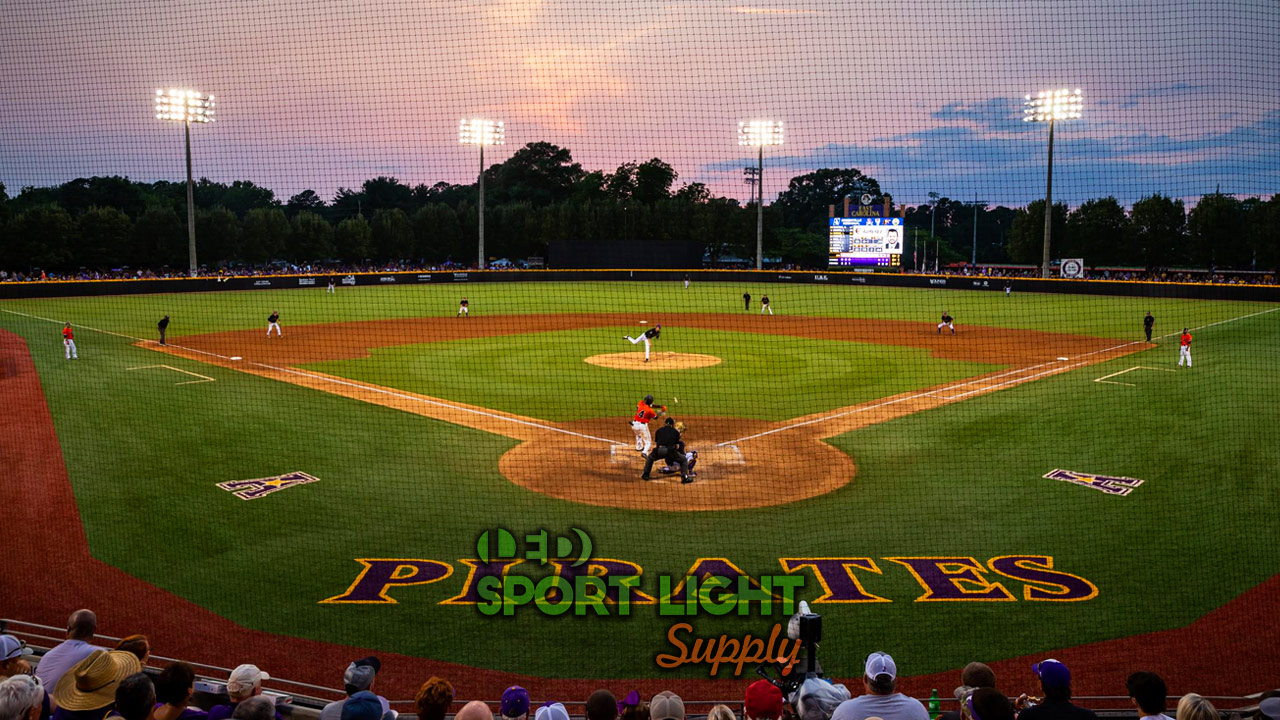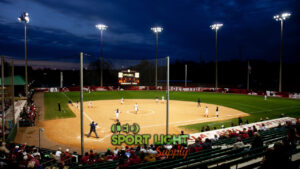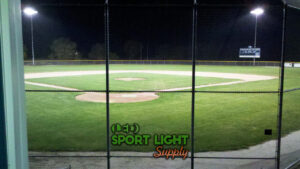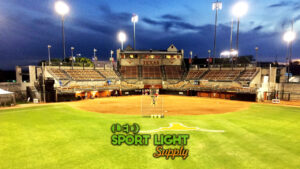This guide is especially for giving you an idea of what kind of baseball or softball field lighting is standard. Depending on the level that your field is designed for, we’ll cover all the details of Lux and lighting uniformity. In the end, you can begin planning the best lighting package that will give you a perfectly lit field.
Why do we need a good baseball field lighting design?
1. Improved baseball player’s vision
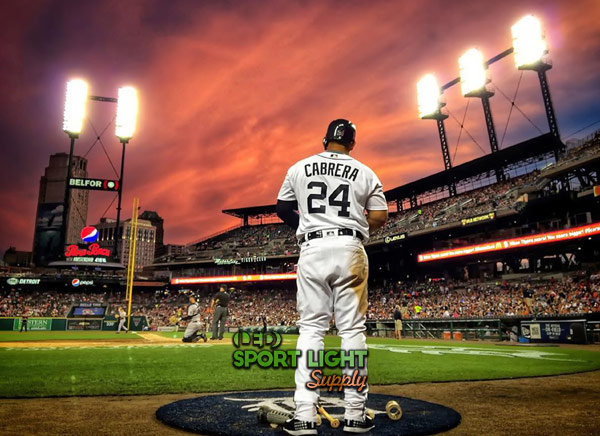 Playing at night is going to be problematic if you can’t see the infield or outfield clearly enough. This is crucial for players who are looking to see where baseball or softball is going. As a team needs to work together, adequate lighting helps them to coordinate their skills on any specific play. Whether it’s to complete a run when the bases are loaded or defense on players who trying to steal plates.
Playing at night is going to be problematic if you can’t see the infield or outfield clearly enough. This is crucial for players who are looking to see where baseball or softball is going. As a team needs to work together, adequate lighting helps them to coordinate their skills on any specific play. Whether it’s to complete a run when the bases are loaded or defense on players who trying to steal plates.
2. Create an atmosphere for spectators
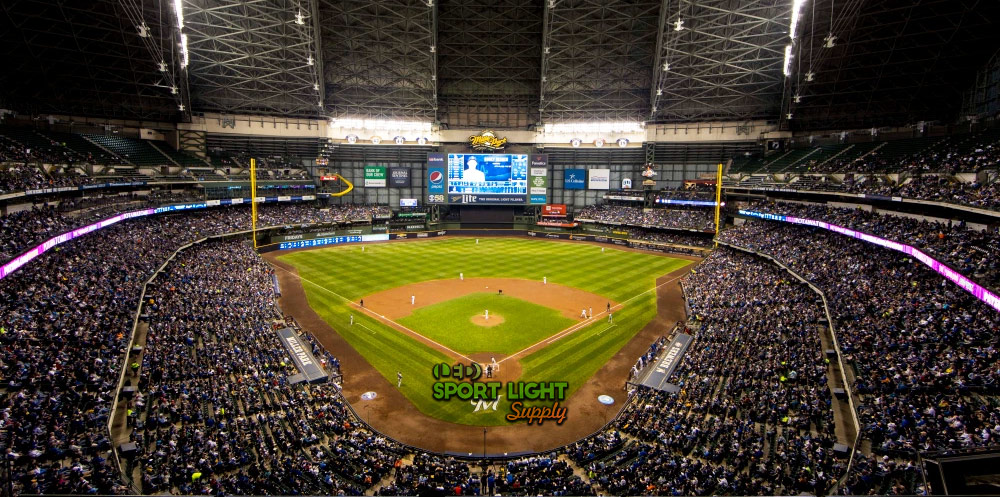
Baseball is an interactive game like no other and those who love baseball share their enthusiasm for tradition. Lighting can provide more than just the core lighting for people to see the game, dramatic and electric lighting effects can enhance moments in between breaks. If you want to increase the mood of your ballpark, special lighting packages can provide colors and effects. This is a bonus that helps keep every game lively and fun.
3. Better lighting for Referee
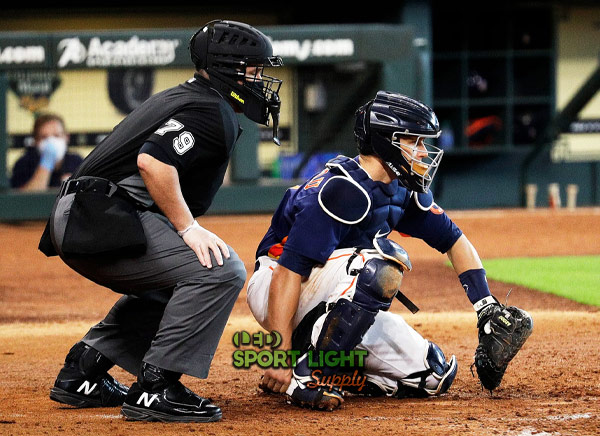 Sometimes the Referee is the last person that any player likes, but they do need to keep the game in check. When ballpark lighting is brought up to the proper level, they can spot and decide on how a play is judged. Low light conditions make it hard to determine if a player was doing something sneaky. So for the sake of fairness, the right amount of light gives them excellent abilities to spot bad form.
Sometimes the Referee is the last person that any player likes, but they do need to keep the game in check. When ballpark lighting is brought up to the proper level, they can spot and decide on how a play is judged. Low light conditions make it hard to determine if a player was doing something sneaky. So for the sake of fairness, the right amount of light gives them excellent abilities to spot bad form.
How to get started with baseball / softball field lighting layout
1. Number of baseball field light poles
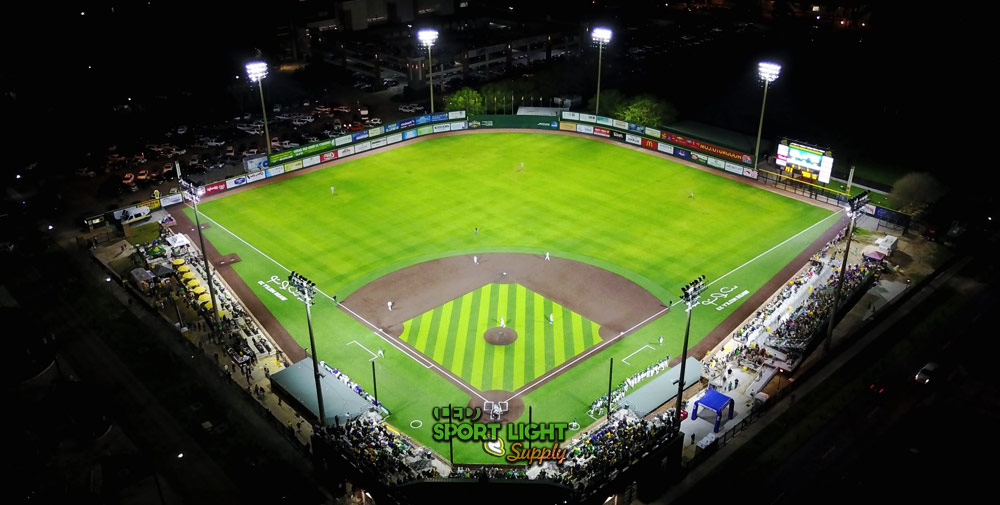
This all depends on the size of a field and the level of play that baseball/softball fields are meant for. There can be 4, 6, or even as many as 8 poles if the park is large enough. We can help determine how many poles are needed based on square meters of the field itself. Yet it all comes down to many other lighting conditions that must be completed as well.
2. Stadium light pole position
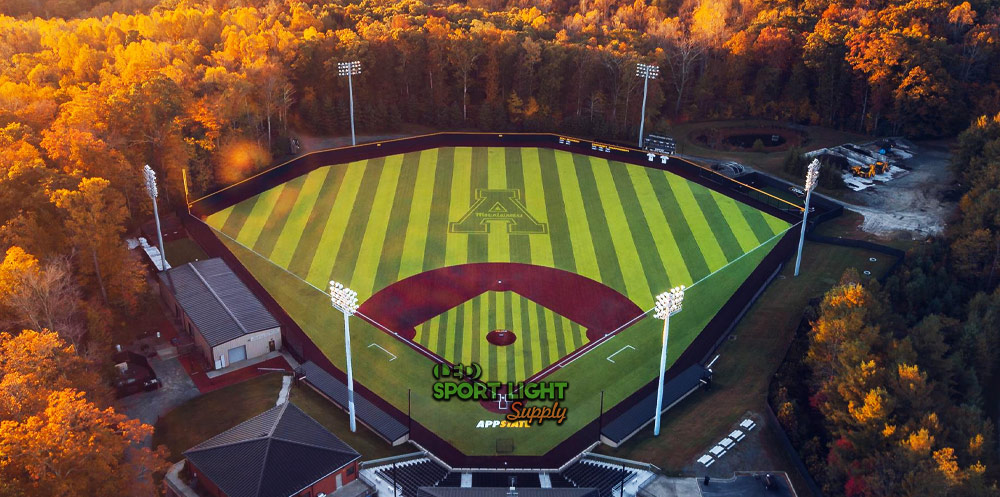
In general, stadium lights are placed at the corners or the sidelines, since these are the most obvious choices. For the best lighting plan possible, the pole height must be determined and Wattage levels estimated. Positioning will also help eliminate glare issues for players and spectators. The positioning of light poles is also very specifically arranged to allow the correct amount of light uniformity requirement.
3. Baseball field pole height
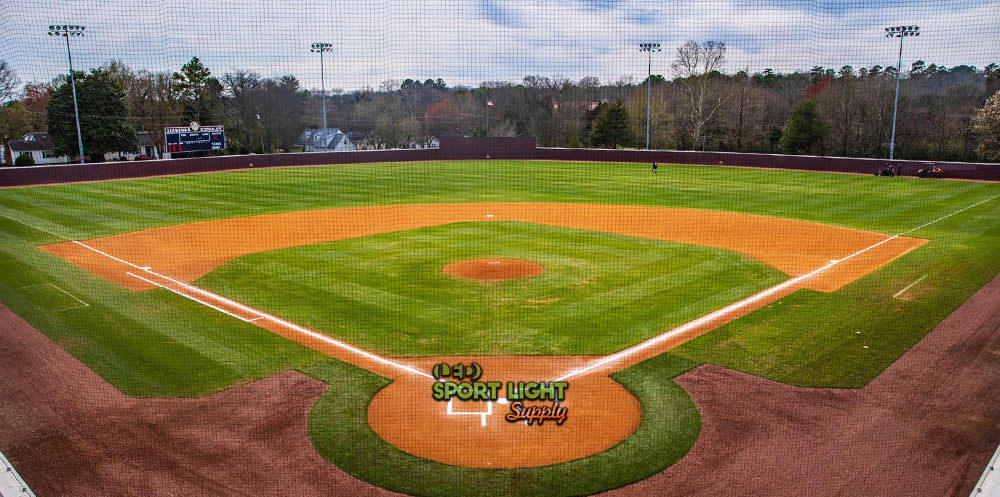
Recreational/training: This is a basic starting point that is only 12-15 meters in height. Little leagues and grade schools will get the most from this since players are smaller and shorter. But for the purpose of training and simple recreation, this pole height is recommended. Local city ballparks, schools, and sports centers will want to consider this modest height since it’s cost-effective.
High school/college: At the very start of serious baseball players who are up and coming, high school and college pole heights are increased. This height will range from 15-40 meters due to the size of the field. It also will be increased further with viewing stands for parents and local spectators. When taller light poles are used, the higher the wattage is needed to light-up the field.
MLB National/International tournament: It goes without saying that professional baseball is a growing global sport. It will be common that 25 to 60 meters are the appropriate height variants determined by stadium size. These high-intensity lights that sit atop high mast lights are packing a punch for maximum illumination. It’s also part of the regulation lighting levels that professional baseball is known for.
4. Infield and outfield
Most people do not know that there is a slight difference in how baseball fields are lit-up. The infield usually needs brighter lights because most of the action within the diamond is where the Referee is watching closely. The outfield doesn’t see so much action except for the occasional pop fly that an outfielder nabs. Lower light in the outfield also helps players to spot the ball without blinding pole lights.
What are the goals of a baseball field lighting design?
1. Proper amount of Lux (brightness level)
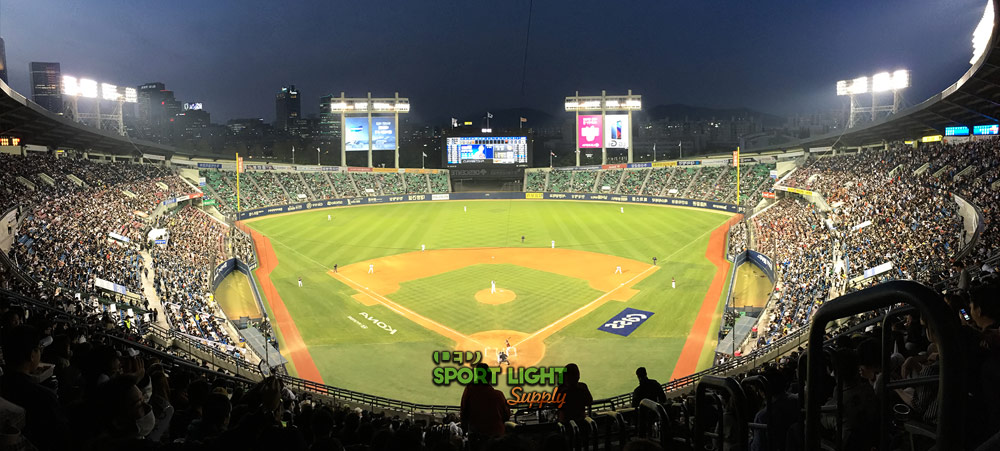
Recreational/baseball club: The most important thing to remember about Lux is the level of brightness that is seen. Objects that are too ‘hot’ are obviously being given too much high-intensity light. Lux levels are adjusted for baseball so that players and the field are seen clearly. For recreational and small local clubs this level is rated at 200-400 Lux. It’s up to the owners of these clubs to increase or decrease this level as they like. Hint: A higher Lux is always better.
Training/college baseball stadium: It will be better for intermediate and semi-professional players to play under 500-1000 Lux. This increases visibility without going overboard. Consider that this level is what any office lighting up to auto body paint shops are using except on a night field. This allows players to see fine details with very little effort. As for the Referee, they can have more of an advantage in making the correct call.
MBL National/ International tournament: For the official ‘Boys of Summer’ they’ll get anywhere between 750-2000 Lux. Since the infield is lit differently, the Lux is usually 2x higher than the outfield. So if the infield needs 500 Lux then the outfield is 250 Lux. Most of the big national games are used to using 1000 Lux in the outfield and 2000 Lux on the infield. This difference might seem pretty drastic, but anything happening in the infield is where most of the action is played out.
2. Lighting uniformity
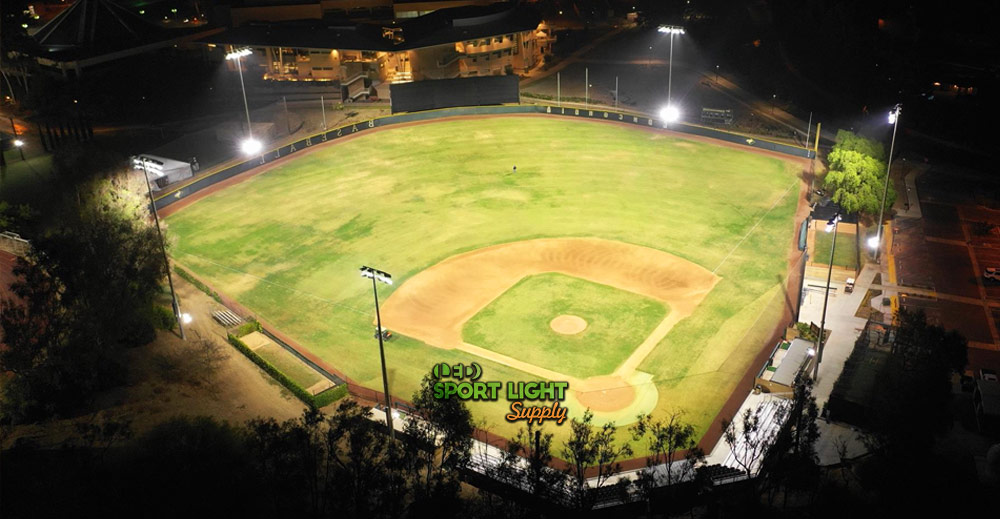
Just to recap what lighting uniformity means is how a field is lit all across the surface. Measurements are taken in square meter sections and the Lux level is recorded. Once a map of the baseball field is completed, these Lux levels tell you how uniform the total field is lit. Each section should have a similar Lux rating however some areas that overlap with light will have slightly higher Lux. The number that’s assigned to the Lux level is what the Lighting uniformity has become.
Training: This number for lighting uniformity is rated at 0.5 and is often within the 200-400 Lux range.
Professional: These higher levels of light uniformity are ranging between 0.6 and 0.7 because of higher Lux. This Lux will be for the college to the national level and reached 500-2000 Lux in this case.
3. Beam angle
It’s important to have a range of 15 to 45 degrees for long-range baseball/softball field lights. This is so the distances involved allow the light beam to expand outward, toward the ground. For lights that are closer to the infield, you’ll need 60 to 90 degrees for these short-range flood lights. This applies to anything on the sidelines and most of the infield.
4. Angle of projection
Good high mast flood light needs to point in a specific direction to achieve the best outcome. If the angle is calculating distance and the correct beam angle, a baseball field will be easier to illuminate. There will be less problematic risks of light loss because these adjustments need to be calculated beforehand. This also results in higher light uniformity using the correct angle for each lamp.
5. Glare
Glare has always been an issue with baseball lighting in the past. With lamps that use halogen, high-pressure sodium, and metal halide, special lenses and light shields were a must. But with all of these measures taken, glare is an issue that is hard to overcome. LED lights have better control of glare using a tighter beam angle lens. This keeps high mast lights from annoying players and spectators due to their lighting layout.
6. Flicker-free
Anytime a baseball game has the television crews around, you can bet they’ll break-out the slow-motion cameras. Aside from that requirement, most ballpark broadcasts are presented in 4K for all the live games. So obviously having flicker-free lighting is a must. Standard lighting like metal halide and halogen need ballast controls to control their flicker issues. LED lighting luckily doesn’t have flicker problems due to the higher rate of flash pulses from the LED itself. Not even slow-motion cameras can detect this so easily.
What lights are used in baseball or softball stadium?
1. High power LED floodlights
The common wattage that you will find being used for baseball fields is a very short range. This will begin with 400, 1000, 1500, and 2000 Watts among the entire list. These are suitable for recreational games, all the way up to professional level baseball events. No matter what level of profession your field is intending, we have the right high power lights that will work best for your field.
2. High mast lighting
Tall high mast lights all need to be outfitted with a narrow beam angle from 15-45 degrees. As light expands outward, tighter beam angles keep a beam from spreading out too quickly. This keeps the light on your field and less likely to become light pollution. The beam angle is also calculated so that light uniformity is spread-out evenly from each of the high mast poles.
3. Color-changing lights
Baseball games can last for hours and there will be moments where there’s not much happening. Don’t forget that the 7th inning stretch will be the perfect time to entertain the crowd. A colorful light show during this break can make a half-time feeling show that gives value to a baseball event. Don’t forget that home runs and feature plays should have spectacle lighting to add to the excitement.
Advantages of using LED lights in a baseball stadium
1. Energy efficient
As opposes to other types of light like HPS, halogen, or metal halide, LED light is simply more cost-effective using wattage. In comparison, the wattage for other lights is 5x higher than LED and will be 5x the cost in return. With lower Wattage used, the overall running cost is attractive and cost-friendly.
2. Longer lifespan
Another incredible benefit to LED lighting is the lifespan is greater than 150,000 hours or more on average. The LED diode is usually the last component within the fixture to ever fail. It’s through several years that internal electronics inside the driver may need replacing. So there’s never any need to change LED bulbs.
3. No warm-up time
Metal halide lamp takes 5-15 minutes to reach full brightness and only gets worse over its’ lifespan. If there is any power cut, the lights need to cool-off before they can be restarted again. LED lights can be turned on and off repeatedly with no operational issues, making them a more precise option.
4. Smart lighting control system
There are light control systems that allow a baseball field owner to control their lighting effects. Support packages such as DMX and DALI light control systems are excellent tools for playing with light sequencing, dimming, and pre-programmed score effects. The newer systems also allow you to control your lights with a smartphone! Ask us how this FX lighting can be added to your baseball and softball field?
5. Light-weight
If the light fixtures are too heavy you’ll need to reinforce the light poles before installation. This is especially important if you already have previous light poles installed from standard filament lights. LED light fixtures are a bit heavier, so it’s recommended to strengthen any poles that were meant for lighter bearing loads.
Common mistakes with baseball field lighting design
1. The light poles are too short- How to Fix:
i. To repair this problem you can use more flood light with a narrow beam angle. This is so the light beam can travel a longer distance away. Of course to get the best results you need to use a narrow beam angle so the light will spread out more evenly. This angle will range from 15 to 45 degrees depending on the shortness of the pole.
ii. Increase the number of light poles that you currently have. Let’s say using 6-8 poles, so each light pole is responsible for a smaller region. If you only have 3-4 lights currently, adding more light poles will give you field proper light uniformity. It can also increase the visibility for the players and spectators.
2. The light poles are too tall- How to fix:
The light loss that comes from very tall light poles leads to light pollution. You’ll need to use more lights to compensate for the light loss. In turn, this will increase the running cost of the lights you already have. It would be best recommended to switch to LED lights that will provide the right wattage to illuminate the ballpark.
i. Although the investment is already an oversight, try to avoid planning to use the taller light poles. Or find a contractor that can cut-down and adapt the pole height using an appropriate height. Tall metal poles can be cut and re-welded in sections that reduce the height gradually. This would be according to the size of the baseball field and the level of competition that you’re catering to.
3. The baseball field lights are too bright- How to fix:
One of the most irritating parts of older filament lights is that they produce glare and light pollution. Not to forget that they’re an incredible waste of electricity and endless repair costs. Most professional baseball fields will often have round-the-clock electricians that have to be on-hand in case of light failures. With LED lighting, these problems are replaced and can be controlled easier.
It’s also very important to get the DIALux photometric report. This is a lighting simulation report that simulates the Lux and light uniformity from the 3D computer software. You can see your field recreated in the digital form how the lighting will appear. Often, it’s better to see how your finished lighting will look from all angles. We provide our DIALux service absolutely for free.
4. Wrong color temperature
With metal halide and HPS lights, the color temperature cannot be controlled, and the light will be uncomfortable for some. Using LED lighting, the correct type of baseball color can be achieved. According to the Kevin chart, the best temperatures for baseball include categories for each level. At the very top of the chart for pro-baseball, it’s a normal requirement that daylight levels are meant for 4K television and mass spectators.
- Recreational: 3000K
- High school/college: 5000K
- Major League- National and International: 6000K
Our final conclusion
Now that you have a better understanding of how baseball lighting works, you’ll want to know how soon LED lighting can be installed. We can get you started by arranging a lighting package that will serve all your lighting layout needs. Whether it’s lights on poles or special lighting controls, we’ll let you know what works best. Of course, it all starts with a DIALux photometric report to show you what can be improved. Call us today.

